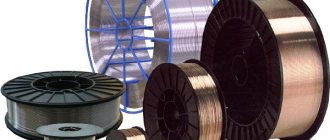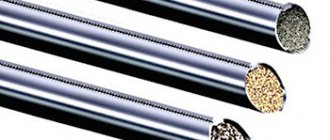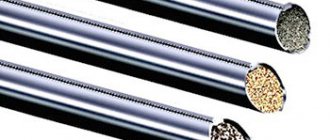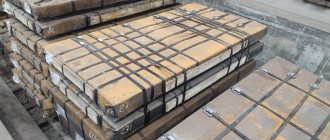- By purpose
- By structure
- By surface type
- According to welded metals and composition
- Steel welding wire
- Copper-plated welding wire
- Stainless steel welding wire
- Aluminum wire
- Cored wire
- What to choose – welding electrodes or wire?
Welding wire is one of the main welding materials used in high-tech semi-automatic arc welding in MIG/MAG shielding gases. It is also used as a filler rod using a non-consumable TIG electrode, as well as a base material for the manufacture of coated stick electrodes for manual MMA arc welding.
When working with an automatic welding machine, all welding processes: wire feeding, ignition, maintaining the welding mode, its completion are mechanized. When using a semi-automatic machine, only the supply of filler material is mechanized; the welding torch is moved manually.
By purpose
Welding wire is classified according to a number of parameters, the main ones being structural features, chemical composition, and specific use.
According to purpose, it is divided into products of general and special use. The first is used when welding all grades of steel (the letters Sv are present in the marking), as well as in surfacing (Np). The second is used when welding special alloys, cast iron, when performing welding work under water, as well as when welding with forced formation of a seam.
In the second case, the chemical composition of the filler material is, as a rule, completely identical to the composition of the base metal.
Chemical composition
Based on the chemical composition, there are 6 grades of low-carbon steel wire, 30 grades of alloy steel wire, and 41 grades of high-alloy steel wire. Alloying elements can be nitrogen (N), tungsten (W), nickel (Ni), silicon (Si), aluminum (Al), zirconium (Zr), chromium (Cr), vanadium (V), titanium (Ti) , molybdenum (Mo), copper (Cu) and niobium (Nb). The following form of marking of welding wire is accepted:
Welding wire marking form
It contains all the necessary information about the composition and purpose of the product.
By structure
In terms of mechanical structure, products are divided into three main types.
Solid (solid section) . The classic and most common option. This is the same wire, which is a solid calibrated metal core obtained by cold rolling. It is from such a workpiece that electrode rods are obtained during the production of electrodes. As an independent filler material it is used in automatic and semi-automatic welding in shielding gases.
Powder . In the marking it is designated by the letter P. It is made in the form of a thin tube, inside of which there is pure flux or flux mixed with metal powder. The share of the latter is 15–40% of the mass of the entire product. When the arc is ignited, thanks to flux and metal powder, a zone of carbon dioxide and slag is formed in the welding area - it protects the deposited metal from oxidation. The weld pool is formed by drops of molten metal wire, covered with a thin layer of slag. The latter is easily removed after welding.
Activated . It also has a tubular shape, but there are significantly fewer powdery substances in it - up to 7%. The role of “activators” during ignition is performed by deoxidizers: titanium, magnesium, silicon oxide; calcium fluoride; alkali metal carbonates. They not only create a protective environment, but also ensure fast ignition and stable burning of the electric arc. Low carbon steel Sv-08G2S is usually used for manufacturing.
Marking
If you look at the photo of the welding wire, you will notice that it is supplied in coils. Each coil must have a tag containing information about the brand, batch, manufacturing plant, and quality control approval.
Domestic wire is designated according to GOST 2246. The marking consists of an alphanumeric code, where the letters are the names of chemical elements, and the numbers are their percentage content. If the amount does not exceed 1%, then the number is not indicated. The abbreviation “Sv” indicates that the wire is welding.
Diamond cutters for stone: options, features, how to chooseLLC GC "TransStroyKomplekt" is a reliable supplier of cast iron products in Russia
Features of diamond blades for wet cutting
So, Sv-08G2S means that we have a welding wire with 0.08% carbon, 2% manganese and no more than 1% silicon.
Imported materials are labeled according to AWS standards.
By surface type
The surface of the products can be copper-plated (denoted in the marking by the letter O) or uncoated. Both options, depending on the task, allow you to obtain a high-quality, even seam. Copper-plated wire is used when welding carbon and low-alloy steels in a protective gas environment (more details below). Copper plating provides:
- improved current supply due to the excellent properties of copper as a conductor;
- reduced resistance when pushing the wire through the feed tip hole;
- more stable arc burning;
- necessary alloying of the weld metal.
Also in this case, the volume of sprayed metal is reduced by 30–40%.
How to choose the diameter
The diameter of the welding wire should be selected based on the thicknesses being welded. The standard range includes the following standard sizes: 0.6 mm; 0.8 mm; 1.0 mm; 1.2 mm; 1.6 mm. For powder electrodes this range is increased to 6 mm.
For welding parts with a thickness of 3-5 mm, wire with a diameter of up to 1.2-2 mm is suitable. For thin-walled products it is better to use 0.8-1 mm electrodes. This will protect you from through burns. Remember that the hole diameter of the welding tip must match the size of the wire.
The second selection criterion is the current value set during welding. To compare diameters and current, you need to familiarize yourself with the corresponding tables.
For welded metals
This is the most extensive classification, which is based on the division of this welding material into types depending on the composition of the metals and alloys themselves.
Steel welding wire
Includes the largest number of brands - more than 50. The diameter of the products varies from 0.3 to 12 mm. Brands form three main groups:
- for medium-alloy and low-alloy steels, wire alloyed with manganese and silicon of the Sv-18KhGS, Sv-08G2S, Sv-08GS grades is used;
- for high-alloy materials, grades Sv-08Kh14GNT, Sv-12Kh13 are used;
- for welding low-carbon steels, wire of a similar composition is used (grades Sv-08, Sv-YUGL, Sv-10G2).
When alloyed with nickel, manganese and chromium, it is possible to join parts made of high-carbon steels. Welding can be performed under submerged arc and in a gas environment (argon, carbon dioxide).
Copper-plated welding wire
Its key advantages were mentioned above: thanks to the copper coating, the product provides good ignition and stable arc burning. Diameter – from 0.6 to 2 mm. Welding is performed in a gas-protected environment; the steels being joined are high-alloy and carbon.
Among Russian analogues, the most often used is the already mentioned steel wire Sv-08G2S with a copper-plated surface (that is, in the marking - Sv-08G2S-O). Copper-plated wires are popular and in demand for low-carbon (grades Sv-08-O, Sv-08A-O) and low-alloy (Sv-08GA-O, Sv-08GS-O, Sv-08ХМ-O) steels.
Due to their high qualities, Esab brand products are widely used (OK PRO 51C, OK Autrod 12.64 and other brands). The product on which such a welding wire is wound is a plastic cassette, which is very convenient for mechanized welding, since the material is fed automatically.
Stainless steel welding wire
Welding on stainless steel involves the use of two types of products - solid section and tubular (powder). In the first case, a protective gas environment is created from the outside (flux is poured into the joint area), in the second, this environment at high temperature is created by minerals, ores, slags and other components of the flux, which is located in the cavity of the tube. Hence another name for tubular wires – self-protecting.
Products are produced with increased (marked with the letter P) and normal accuracy according to GOST 18143-72, diameter - 0.13... 6.0 mm. Thus, the abbreviation PP means “high precision powder”.
The most important parameter by which welding wire for stainless steel is selected is strict compliance with the chemical composition of the metals - filler and base. Among the most commonly used wire grades are SV01Х18Н10, where the proportion of Cr in the composition is <20%, Ni <12%; SV06Х20Н11М3 – they are used for joining austenitic chromium-nickel steels (12Х18Н10Т, 08Х18Н10, 08Х18Н12Б, 03Х18Н11 and other grades).
Aluminum wire
The standard according to which aluminum welding wire is produced is GOST 7871-75. An important detail: the vast majority of welded products are made not from pure aluminum, but from alloys based on it. Alloying additives add strength, ductility to this metal, improve anti-corrosion and other properties. The most commonly used wire grades:
- Sv1201 – used for welding alloys with the addition of copper (up to 5%);
- SvAK5 – used for joining parts made of aluminum-silicon alloys (Si content up to 3%);
- SvA85T, SvA99 – these grades are used to weld alloys containing magnesium (up to 5%).
Welding is carried out in protective gas environments.
When working with aluminum alloys, the chemical composition of the wire must be identical to the composition of the parts being welded. The exception is an alloy of aluminum and magnesium. Due to the active evaporation of Mg during welding, it should be 10-20% more in the consumable material to replenish the required volume in the weld metal.
Cored wire
And once again to the tubular, self-protected wire. We have already talked about the principle of its operation during welding. We will indicate the brands and features of the composition of the flux that is used in such welding tubes.
- PP-AN8, PP-AN10 – the main part of the flux is rutile filler (titanium dioxide). Allows you to obtain a high-quality seam when working with medium-carbon steels.
- PP-AN4, PP-AN9, PP-AN20 (titanium dioxide plus fluorite - fluorspar). Welding is carried out on low-alloy steels.
- PP-AN1 (titanium dioxide plus carbon compounds). Used for welding parts made of low carbon steels.
- PP-2DSK – with fluorite filler (fluorspar mineral), for low-alloy and low-carbon steels.
Brands PP-AN11, PP-AN17 are also used (carbonate compounds are added to fluorite - salts of carbonic acid). They are used for connecting critical structures made of low-alloy and low-carbon steels.
Characteristics of steel wire
This type of product can be used in any field. Most often it is chosen for construction and industrial work. It can be classified according to several criteria.
The main ones are strength, cross-section, diameter and alloy used for production.
Today, a large number of varieties of such material are known. In turn, they are divided into:
- Welding;
- Spring;
- Reinforced;
- Ropeway;
- Prickly.
The diameter depends on the type of consumable. Popular brands are divided into several types:
- For working with low carbon steels;
- For fixing medium and low alloy alloys;
- For welding high-alloy substrates.
Most steel consumables can be copper plated. As a result, it helps protect the weld surface from further oxidation and also improves the quality of work.
What to choose – welding electrodes or wire?
Both materials solve one problem - they allow you to obtain a high-strength, high-quality weld. In the end, the wire itself plays the role of a welding electrode during the work process. However, the methods for solving such problems are technologically different.
- Electrode rods are coated and provide alloying of the weld metal not only due to the metal of the rod, but also the composition of the coating. Alloying in the case of wire is provided only by its metal.
- Wire welding is always a mechanized process, semi-automated or fully automatic.
- When welding with electrodes, a protective gas environment is not required. In addition, it can be created in hard-to-reach places - directly on the construction site, which is impossible or difficult in the case of stationary machines.
However, in some cases, welding wire is preferred. In particular, it is recommended when working with stainless steel, which is quite difficult to cook. It is this that allows you to obtain a perfectly precise connection when working with critical structures - in the case of MMA, only an experienced professional welder can give the same result.
In addition, electrodes often require preliminary calcination - and this is an additional working step that requires appropriate equipment and time (from half an hour to two hours). Finally, the issue of price also plays an important role: wire is much cheaper than coated electrode rods.
Samples of these products are presented in the catalog. Here you will find welding wire in coils, barrels and cassettes (coils), as well as in rods. The high quality of products from leading manufacturers is confirmed by certificates.










